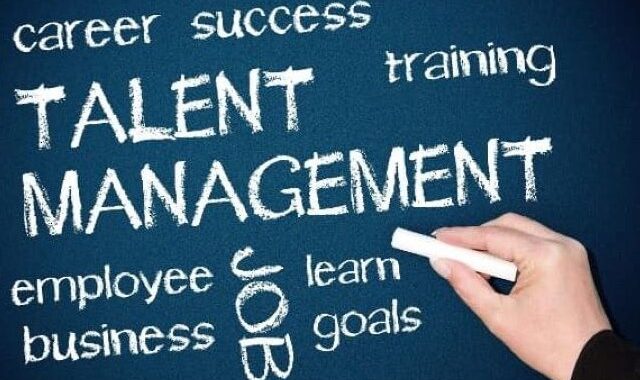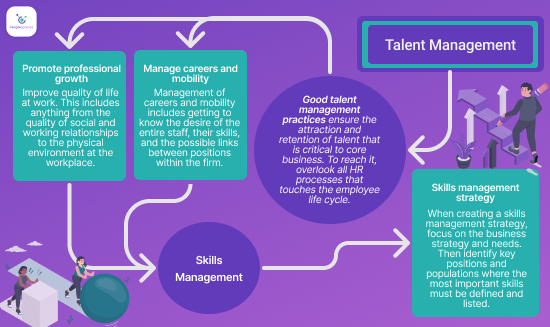
Dealing with a large staff turnover is never an easy HR challenge to resolve. Talent management is an essential element of human resource management for companies to deal with in order to avoid the best talent leaving for other companies with better potential especially when dealing with newer generations. For example, a recent study mentions that:
47% of actively disengaged Millennials strongly agree that they will switch jobs if the job market improves in the next 12 months, compared with 17% of engaged Millennials.
Harvard Business Review
Talent management statistics tell us that answering employees’ needs is crucial in retaining employees. For this reason, we decided to take a looks at some tips for improving talent management practices, including the need for an efficient HR system customized to your business goals.
Related articles:
5 Tips to Promote the Professional Growth of Your Employees
How to Create your Own Skills Inventory Using No-Code Tools
What is Talent Management?
Talent management is a broad topic that includes many HR processes and categories. In general, talent management is the full scope of how the HR department treats its human capital resources during the entire employee life cycle. This includes the recruitment process, onboarding, development, motivation, and more. Keeping and leveraging the right talent in a company through a talent strategy is essential for organizational development.
Talent management can also be considered strategic HR for HR teams to improve employee retention. This is important as newer generations are now part of the workforce and different techniques of management should be put into place. According to Gallup:
Gen Z and millennials now make up 46% of the full-time U.S. workforce
These new generations want a different talent management than how business used to to be. They prioritize “their desire for ethical leadership” from opportunity to learn and grow to quality of management”.
Why Should SMEs Concentrate on Talent Management?
Large companies have the means to invest a lot in talent management and commit to high-potential initiatives by creating talent management hierarchies and departments dedicated to attracting and retaining the talents that are critical to their core business. By aligning talented people within the company to organizational goals, employee development and loyalty is likely to improve. But small and medium-sized enterprises (SMEs) often don’t have the same means regarding talent management and must make choices based on resource planning with limited assets.
“Small business” means “small workforce“. When a company’s know-how relies on just a few employees, each resource, taken individually, becomes a critical talent and skill. And when one of the employees is no longer able to perform his duties, for example by a competitor acquiring the talent, the entire company is at risk. That is why it is essential to pay particular attention to competitors’ approach to talent and to reflect on your own management of talent and key skills.
Moreover, in times of crisis, what makes a company attractive to talent and young graduates is the security and career development opportunities that the company provides. When talent management is neglected in favor of old-fashioned management, it affects turnover as well as individual and global motivation. This can be seen in a Gartner study that reports:
65% of staff is rethinking the role of work in life
This is the staff that is already trained and which resources went to which causes weaknesses for the company. The HR department must focus its management processes on human capital management and not only attracting talented employees, but also keeping them. This will give you a competitive advantage in the war for talent.
What customers are looking for in their collaboration with an SME is expertise first and foremost and also flexibility. These elements should be found in talent management and, among other things, in the process of developing skills and making employees experts in their roles. The positive differentiation for SMEs is therefore the management of individual key skills that, when put together, will produce a truly unique overall collective skill set.
Obstacles to Effective Implementation of Good Talent Management
There are multiple obstacles of various natures. First, HR professionals are generally “stuck” in the day-to-day management and administration of the company’s HR management, so they very rarely have the opportunity to think about a talent management strategy. Even if the right questions are asked for talent development, HR professionals usually have neither the time nor the human and financial resources to change their HR strategy or how they manage talent.
As a result, the CEO is often the only real player in the management of talent, but unfortunately, they are not always available to concentrate on managing talent as their priorities are often with other business needs.
Because the idea of adopting a talent management solution is usually long, time-consuming, and expensive, an HR manager at an SME wants to avoid the arduous task of implementing an HR solution they only deem suitable for large companies and are often led to creating their own tools by “reinventing the wheel”. What matters most is not the highly specific nature of the management solutions but the way the tools are used and the corresponding results.
Executing Good Talent Management
How do you execute good talent management? Since it is a very broad topic, your HR department needs to overlook all its HR processes in order to execute good talent management. For example, your company can have a good recruitment process to attract and recruit talent but lack the management for retaining talent. You need to look over your talent acquisition practices and align them with your talent and performance management practices. Investment in HR technology that supports a talent management system is crucial.
Promote Professional Growth
In order to motivate and retain top talent within your company, you should promote professional growth and maintain a good quality of work life. Although there is no real definition of “quality of life at work”, it can be considered a feeling of well-being at work perceived by individuals and collectively. This can be anything from the quality of social and working relationships to the physical environment at the workplace.
Manage Careers and Mobility
Besides promoting professional growth within your business as a part of your talent management practices, you should also manage careers and mobility. Good careers and mobility management lead to an increase in business performance. When starting to manage the careers and mobility of your employees, get to know the desire of each of your employees, their skills, and the possible links between positions within your firm.
Career Management
Career management is focusing on skills and putting them at the heart of management. As their supervisors, managers have a position of choice to guide their employees throughout their career development. Creating a career path supports employees and help them to have a clear vision of what their future will look like. Indeed, career management defines what skills they want to learn, what certification they want to take and basically, what they want their career to look like! Career management is also a great way for you company to get insights into their talent and skills management strategy.
Individual Development Plan
An Individual Development Plan (IDP) is a strategic HR tool designed to support employee growth and career progression through a collaborative process between the employee and supervisor. The IDP outlines specific career goals, skills to be acquired, and steps for achieving these objectives. It involves five key steps: self-assessment, goal setting, identifying learning opportunities, creating an action plan, and monitoring progress. Regularly updated, the IDP promotes continuous learning, enhances job satisfaction, and aligns individual aspirations with organizational needs.
Skills Management
At the heart of integrated talent management, lies skills management, the management of the individual and collective skills of a company. Whether it’s a team in an office or a culinary staff, management of skills and competencies is vital for company success and needs to be optimized.
Knowledge, Skills and Abilities
Understanding and mastering knowledge, skills, and abilities (KSAs) are essential for individual career advancement and organizational success.
- Knowledge is the theoretical understanding and factual information gained through education and experience, forming the foundation upon which skills and abilities are built. Knowledge management in an organization involves capturing the collective expertise and experience of an organization and making it accessible to others.
- Skills are the practical competencies that allow individuals to perform tasks effectively and can be technical or soft, developed through practice and experience. Skills management includes assessing current skills, identifying gaps, providing training and development opportunities, and aligning individual skills with organizational needs.
- Abilities refer to the natural aptitudes that influence how well individuals can perform tasks and adapt to new challenges. Unlike skills, which are often learned through training, abilities are more inherent and relate to an individual’s potential to perform certain tasks or functions.
HR Directors play a crucial role in leveraging KSAs to build a competent workforce and drive organizational success. Aligning KSAs with organizational goals enhances performance and innovation while implementing succession planning ensures long-term success. Ensuring knowledge transfer, promoting cross-functional collaboration, and fostering adaptability to market changes are strategies to drive innovation and growth.
Skills Management Strategy
When creating a skills management strategy, it is important to focus on the company’s strategy and needs and then identify key positions and populations where key skills must be defined and listed. Using this data, your HR department should develop a skills inventory, a thorough compilation of the education, experiences, and career skills of employees within an organization. Creating a skills inventory from scratch might seem like a big task, but this process can be simplified with cloud-based human resource software, like PeopleSpheres.

What HR Solution is Recommended for SMEs?
SMEs need to stop multiplying management tools and adopt a unified platform from the start that focuses on skills, implements best practices, and can be up and running with relevant workflows in less than 6 months via a methodology based on the “quick win” logic that is associated with a fast-paced environment.
Thus, with the first step completed, SME managers can begin to delegate within a flexible and secure framework. The human resources manager will have the opportunity to focus on the effective management of the company’s talent and will quickly benefit from the unified dashboard model, comparing different HR functions which are conducive to decision-making.
From a financial point of view, it is necessary to opt for a cost model adapted to the use and small budget of SMEs in which the initial investment is almost zero. Centralization is also a key cost-saving factor that SMEs should consider. By having consolidated human resource management systems, managers can compare and analyze important HR metrics gathered from separate HR solutions, such as employee engagement, learning and development, time & attendance, and more. This is essential in getting an overview of your people management.
How to Take a Global Approach in Less than 6 Months
First of all, by choosing the right partner for their human resources management system, HR professionals will be able to make recommendations without unnecessarily using up the SMEs resources.
Then they can adopt a preconfigured “turnkey” solution, with business-specific skill models, training content, and key processes that reflect industry best practices.
The SME will thus obtain a sound foundation on which it will be able to build, over time, its own talent management policy and introduce its specificities.
Tangle and Short-Term Benefits from the HR Solution
For companies with 50 to 1,000 employees, “a turnkey approach” including advice, technology, and assistance is the fastest and most effective solution.
With the right HR software, the company will be able to quickly evolve and respond to requests by being aware and informed of the skills within its teams, and employees will be more proactive in their employee training, career development, and employee performance.
This plays a big role in terms of motivation and has an immediate and strong impact on productivity throughout the employee lifecycle, while at the same time reducing the unwanted turnover of good employees.



 (1)-666x380.jpg)

